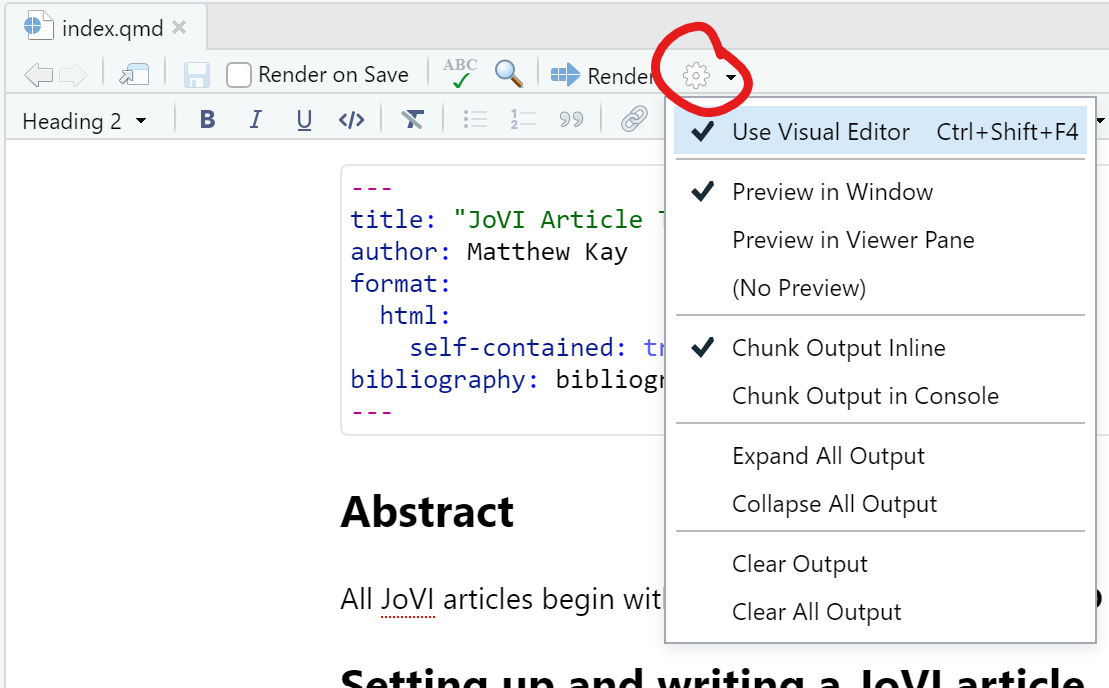This template is intended for the experimental track at JoVI.
This template describes how to set up the Quarto environment for writing a JoVI article, provides instructions and templates for content that should be included in every JoVI article (such as the structured abstract and authorship metadata), and gives brief examples of some useful functionality for writing papers (such as how to include figures and citations).
If you have not setup Quarto or the JoVI template yet, skip to the Setup section below.
We highly recommend all JoVI articles use a structured abstract. Structured abstracts provide a succinct overview of an article using a common set of sections. Which sections are used depends on the type of research and its goals. For example, articles with empirical methods should have a data collection section, while articles that do not analyze data to support a conclusion do not need such a section.
Your paper may fall into multiple types of work. We provide some example sections you may want to include in your structured abstract below, depending on the type of work. You can use the example sections to fill in the subsections that apply to your paper, then delete these first two paragraphs and the subsections that do not apply to your paper. Please add, merge, rename, or re-order sections if you feel that would improve clarity. We have some (partial) examples of structured abstracts here.
Introduction
The research question and a succinct motivation for answering it.
Theory/model
For theories or models: A description of the theory or model, its key organizing principle, or new insights that might be gained from it
Data Collection or Source
For empirical research, reanalysis, or meta-analysis: An overview of experiment and/or data collection procedures. Mention if the collection was prespecified (via preregistration) or exploratory. For reanalyses or meta-analyses, citations of the original sources are sufficient. This section does not apply to articles that only use datasets for demonstrations.
Data Analysis
For empirical research, reanalysis, or meta-analysis: An overview of analysis approaches used as evidence for conclusions. This section does not apply to articles that only use datasets for demonstrations.
Analysis Results
For empirical research, reanalysis, or meta-analysis: A summary of the analysis findings
Implementation
For systems or techniques: How was the application or system implemented?
Demonstration
For systems or techniques: A description of any demonstrations or functionality that exemplify the utility of the system
Conclusion
An interpretation of results, lessons learned, etc. in the context of the research question and its implications. Avoid overgeneralizing, and avoid broad behavioral claims without strong evidence.
Materials
Link to repositories containing raw data, open source code or (pre-)registration number/links.
Fill in the following sections in this infobox per the JoVI Author Guide, then delete this line.
Setting up and writing a JoVI article
Articles on the JoVI experimental track are written in Quarto, which is a simple markdown-based text format. This template outlines some of the features that are most useful for writing academic articles in Quarto; for more visit https://quarto.org.
You can find the source for this article in the journalovi/jovi-template-quarto repository on Github. To create a new JoVI article, we recommend following these steps:
Install Quarto by following these instructions.
Create a new git repository to hold your article by forking our template repository.
You can then edit index.qmd in your new repository to write your paper. There are several options for editing and rendering the paper:
You can execute quarto serve from the commandline to render the paper to index.html and preview it in the browser.
You can edit the paper in RStudio and render it by clicking on the Render button:

If you plan to use RStudio, read more about RStudio and Quarto here. In particular, you should install RStudio > version 1.5. If you do, you can also enable the visual editor:

Body text
The basic body text, header formatting, and basic tags such as links, emphasis, etc should be left as-is except in rare cases (for which you should be able to demonstrate the value of your modifications). That said, we do encourage experimentation with what is possible in this format; some possibilities that just scrath the surface include: using color or other formatting to link text content semantically with figures; using inline figures; experimenting with interactive widgets in text and figures. So long as content retains archivability, accessibility, and readability, we welcome experimentation with the format.
Code
Quarto supports R and python code; for example:

